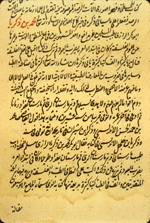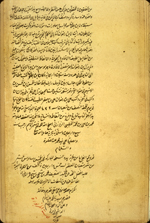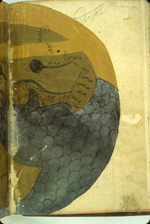Catalogue: Medical Monographs
-
 Ta’rīkh-i ḥukamā’ (MS A 72)
Ta’rīkh-i ḥukamā’ (MS A 72) - (The History of Learned Men)
- كتاب تأريخ الحكماء
- by ‘Alī ibn Yūsuf Ibn al-Qifṭī (d. 1248/646)
- على ابن يوسف ابن القفطى
Ibn al-Qifṭī's Arabic biographical dictionary, as it is preserved today, provides information on the lives and writings of 414 learned physicians, philosophers, and astronomers, including Greeks, Indians, and Persians. The text preserved today, however, is only an edition or extract from a longer original treatise titled Kitāb Ikhbar al-‘ulama' bi-akhbar al-ḥukamā’ (Notices of Scholars with the Accounts of Learned Men) which is now lost. The extract, which circulated under the title Ta’rīkh-i ḥukamā’, was made in 1249/647, a year following Ibn al-Qifṭī's death, by Muḥammad ibn ‘Alī ibn Muḥammad al-Khaṭībī al-Zawzanī.
The NLM copy was completed in 1636/1045.
The text has been published in: Ibn al-Qifṭī's Ta’rīkh-i Ḥukamā’, auf Grund der Vorarbeiten Aug. Müllers, herausgegeben von Julius Lippert (Leipzig, 1903). NLM's copy was not used for this edition. No translation has been published. For a general discussion of the treatise, see Françoise Micheau, "Great Figures in Arabic Medicine According to Ibn al-Qifti", pp. 169-183 in Health, Disease and Healing in Medieval Culture, ed. by Sheila Campbell, Bert Hall, and David Klausner (New York: St Martin's Press, 1992).
For other copies, see Ullmann, Medizin, p. 231 note 8; and Sami Hamarneh, "Arabic Historiography as Related to the Health Professions in Medieval Islam", Sudhoffs Archiv, vol. 50 (1966), pp. 2-24, esp. p. 16 note 2.
Ta’rīkh-i ḥukamā’ (MS A 72)
Illustrations
At the lower half of the page is the beginning of Ibn al-Qifṭī's account of the life of the 9th-century physician Abū Bakr Muḥammad ibn Zakarīyā’ al-Rāzī (Rhazes). From the Ta’rīkh-i ḥukamā’ (The History of Learned Men) written by Ibn al-Qifṭī in the 13th century. The copy was made in 1636/1045.
The colophon of a copy made in 1636/1045 of the Ta’rīkh-i ḥukamā’ (The History of Learned Men) written by Ibn al-Qifṭī in the 13th century. In this colophon it is stated that Ibn al-Qifṭī's treatise was edited in the month of Rajab in the year 647 [October-November 1249] by Muḥammad ibn ‘Alī ibn Muḥammad al-Khaṭībī al-Zawzanī, and that this copy was completed on 16 Sha‘ban 1045 [25 January 1636] by the copyist Muḥammad ibn shaykh ..?.. ibn shaykh ‘Umar al-Akhrawī.
Physical Description
Arabic. 140 leaves (fols. 1b-149b). Dimensions 204. x 12.1 (text area 15.4 x 6.8) cm; 23 lines per page. The title is given as Kitāb al-Ta’rīkh (The Book of History) is given in colophon (fol. 140b line 14). The author is not named in manuscript; a comparison with the published text of Ibn al-Qifṭī's History of Learned Men demonstrates that this is a copy of that treatise.
The copy is dated in the colophon (fol. 140b lines 21-22) where it is said that the copyist Muḥammad ibn shaykh ..?.. ibn shaykh ‘Umar al-Akhrawī completed it on 16 Sha‘ban 1045 (= 25 January 1636). It is also stated in the colophon (fols. 140b, lines 14-15) that the treatise was edited in the month of Rajab in the year 647 (October-November 1249) by Muḥammad ibn ‘Alī ibn Muḥammad al-Khatibi al-Zawzani.
The volume consists of 140 leaves and one preliminary leaf. Fol. 1a is blank except for six owners' notes and stamps, some bearing the dates 1211 (1796), 1213 (1798) and 1288 (1871). The preliminary leaf is blank except for a note regarding the title and an owner's note, placed on the recto side.
A complete copy. The text is in a small, compact naskh script written in black ink with headings in red. There are catchwords.
There are scattered marginal corrections.
The ivory paper is thin, burnished, and watermarked (with a crown); some leaves are of different colors.
Binding
The volume is bound in front and back covers and envelope flap of marbled paper over pasteboards, with brown leather edges, spine, and foredge flap. There are pale green paper pastedowns and modern paper endpapers.
Provenance
On fol. 1a there are six owner's notes and stamps, some bearing the dates 1211 (1796), 1213 (1798) and 1288 (1871).
The volume was purchased in 1941 by the Army Medical Library from A.S. Yahuda (ELS 5546).
References
Schullian/Sommer, Cat. of incun. & MSS., entry A 72, p. 321.
NLM Microfilm Reel: FILM 48-126 no. 5
-
 Ta’rīkh-i ḥukamā’ / Tarjamat-i Ta’rīkh-i ḥukamā’ (MS P 17)
Ta’rīkh-i ḥukamā’ / Tarjamat-i Ta’rīkh-i ḥukamā’ (MS P 17) - (The History of Learned Men / The Translation of The History of Learned Men)
- تاريخ حكماء / ترجمة تاريخ الحكماء
- by Shams al-Dīn Muḥammad ibn Maḥmūd al-al-Shahrazūrī (fl. late 13th century)
- شمس الدين محمد ابن محمود الشهرزورى
In the late 13th century Shams al-Dīn Muḥammad ibn Maḥmūd al-al-Shahrazūrī composed in Arabic a biographical dictionary concentrating on Greek and early Islamic scholars, titled Nuzhat al-arwah wa-rawdat al-afrah. It contained biographical notices of 34 pre-Islamic and 77 Islamic philosophers, scholars, and physicians, including Hippocrates, Galen, Ḥunayn ibn Isḥāq , and al-Rāzī.
According to the NLM copy, the Persian translation was made in the year 1011 [1602-3] by Maqsud ‘Alī Tabrizi, who added a section on Muslim philosphers. Other sources, however, state that the Persian translation was begun in 1605/1014 for the Mughal ruler Jahangir; see Keshavarz, "Wellcome", pp. 542-3 entry 368.
NLM has a copy of only the Persian translation, and not the original Arabic.
The treatise has not been published or translated.
For other copies, see Keshavarz, "Wellcome", pp. 542-3 entry 368. For the Arabic original, see Ullmann,
Medizin, p. 232; and Sami Hamarneh, "Arabic Historiography as Related to the Health Professions in Medieval Islam", Sudhoffs Archiv, vol. 50 (1966), pp. 2-24, esp. pp. 17-18.
Ta’rīkh-i ḥukamā’ (MS P 17)
Illustrations
The beginning of the Persian translation of the biographical dictionary of Greek and early Islamic scholars written in Arabic in the 13th century by Shams al-Dīn Muḥammad ibn Maḥmūd al-al-Shahrazūrī. The Persian translation was made by Maqsud ‘Alī Tabrīzī, who added a section on later Muslim philsophers. This copy was made between 1602 and 1627, when an owner's note was added.
Physical Description
Persian. 247 leaves (fols. 1b-248a). Dimensions 26.4 x 15.5 (text area 16.0 x 7.8) cm; 17-18 lines per page. The title Tarikh-i hukama' is taken from near the beginning of the text (fol. 2a line 8). The author's name is given in the text (fol. 2a line 9) as: Shams al-Dīn Muḥammad i Suhravardi; the name is written Suhravardi, as in the India Office copy (H. Ethe, Catalogue of Persian Manuscripts in the India Office Library (Oxford, 1903), vol. 1, cols. 249-250), rather than the more common form of Shahrazūrī.
The Persian translation was made by Maqsud ‘Alī Tabrīzī. According to a statement made in this copy, on fol. 3b line 5, the translation was made in the year 1011 [=1602-3], and the name of the translator is given on fol. 2b, line 15, as Maqsud ‘Alī Ḥakīm.
The copy is undated and unsigned. It must, however, have been made between 1602, when the translation into Persian was said to have been made, and 1627-8, the date of an owner's note on fol. 1a.
A complete copy of the Persian translation. In the NLM copy, the biographies of Hippocrates, Ḥunayn ibn Ishāq, and al-Rāzī are to be found on fols. 128a, 178a, 188b, and 190b respectively. There are catchwords.
There are some marginalia, including marginal corrections and marginal headings.
The paper is brittle and yellow-brown, with only laid lines visible; some leaves dyed pink. The paper is water damaged and wormeaten, and the edges have been repaired and strengthened.
The volume consists of 248 leaves. Folio 248b is blank. Fol. 1a is blank except for owners' notes and stamps, one dated 1037 [1627-8].
Binding
The volume is bound in a modern library binding of red leather over pasteboards. There are modern endpapers and pastedowns.
Provenance
On fol. 1a there is an owner's stamp dated 1037 [1627-8].
The volume was acquired in 1941 by the Army Medical Library from A. S. Yahuda (ELS no. 2713, A36).
References
Schullian/Sommer, Cat. of incun. & MSS., entry P 17, p. 335.
NLM Microfilm Reel: FILM 48-134 no. 5













